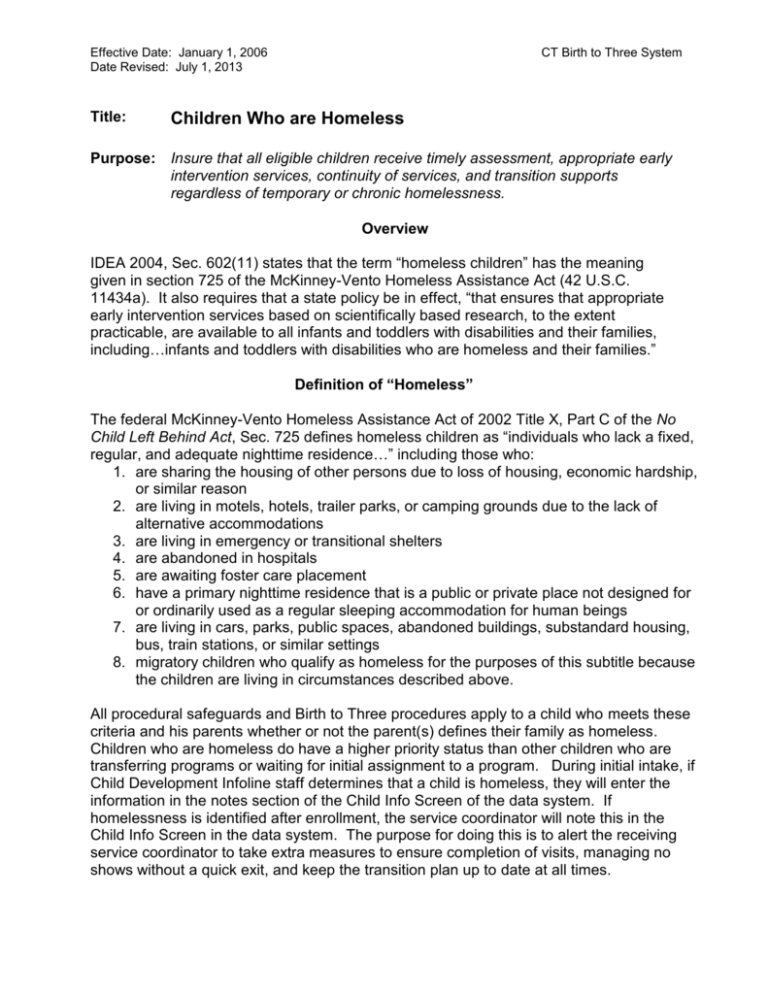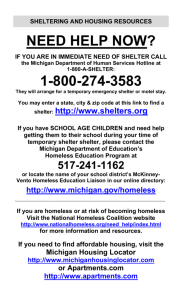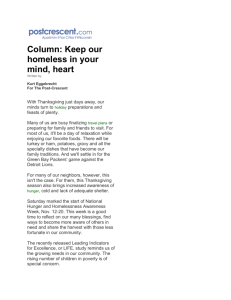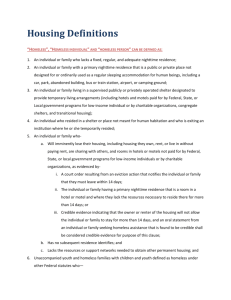Assistive Technology - Connecticut Birth to Three System
advertisement

Effective Date: January 1, 2006 Date Revised: July 1, 2013 Title: CT Birth to Three System Children Who are Homeless Purpose: Insure that all eligible children receive timely assessment, appropriate early intervention services, continuity of services, and transition supports regardless of temporary or chronic homelessness. Overview IDEA 2004, Sec. 602(11) states that the term “homeless children” has the meaning given in section 725 of the McKinney-Vento Homeless Assistance Act (42 U.S.C. 11434a). It also requires that a state policy be in effect, “that ensures that appropriate early intervention services based on scientifically based research, to the extent practicable, are available to all infants and toddlers with disabilities and their families, including…infants and toddlers with disabilities who are homeless and their families.” Definition of “Homeless” The federal McKinney-Vento Homeless Assistance Act of 2002 Title X, Part C of the No Child Left Behind Act, Sec. 725 defines homeless children as “individuals who lack a fixed, regular, and adequate nighttime residence…” including those who: 1. are sharing the housing of other persons due to loss of housing, economic hardship, or similar reason 2. are living in motels, hotels, trailer parks, or camping grounds due to the lack of alternative accommodations 3. are living in emergency or transitional shelters 4. are abandoned in hospitals 5. are awaiting foster care placement 6. have a primary nighttime residence that is a public or private place not designed for or ordinarily used as a regular sleeping accommodation for human beings 7. are living in cars, parks, public spaces, abandoned buildings, substandard housing, bus, train stations, or similar settings 8. migratory children who qualify as homeless for the purposes of this subtitle because the children are living in circumstances described above. All procedural safeguards and Birth to Three procedures apply to a child who meets these criteria and his parents whether or not the parent(s) defines their family as homeless. Children who are homeless do have a higher priority status than other children who are transferring programs or waiting for initial assignment to a program. During initial intake, if Child Development Infoline staff determines that a child is homeless, they will enter the information in the notes section of the Child Info Screen of the data system. If homelessness is identified after enrollment, the service coordinator will note this in the Child Info Screen in the data system. The purpose for doing this is to alert the receiving service coordinator to take extra measures to ensure completion of visits, managing no shows without a quick exit, and keep the transition plan up to date at all times. Children Who are Homeless page 2 Timely evaluation and assessment The timelines, evaluation tools, criteria and personnel involved in completing an eligibility evaluation or assessment for a referred or enrolled child are exactly the same for a child identified as homeless as for any other child who is referred to, or enrolled in, the Connecticut Birth to Three System. Refer to the procedures for Evaluation, Assessment, Transfer, Transition, and Family Handbooks and Videos for more details. Evaluations or assessments should be completed in the child’s natural environment, which may include a homeless shelter, domestic violence shelter, or substance abuse rehabilitation shelter. The location of the evaluation or assessment should be chosen with the parent after discussion and consideration of the level of distractions, familiarity and comfort for the child, privacy and safety, and confidence that the testing situation permits a valid indication of the child’s current abilities and areas of need. Appropriate Early Intervention Services and Placement Eligible infants and toddlers must receive the same types of services that the parent’s values and priorities, the child’s needs, and research-based practices indicate as being appropriate without consideration to homeless status. An IFSP must be developed according to procedural timelines and implemented accordingly. Services must be provided in a natural setting which may include a shelter or other location where children without disabilities live, learn and play, unless the child’s early intervention outcomes cannot be achieved in a natural environment. For homeless families residing in a shelter, parental permission may be sought to include shelter staff on the IFSP team, if appropriate, especially to reduce the possibility of parallel efforts to secure parental employment or housing if they are desired family outcomes. Birth to Three providers should be aware of and sensitive to the possibility that the parent may be more concerned about securing housing or other basic needs for themselves and their child than about any particular developmental progress or regression the child may be showing. Birth to three providers should also be aware and respectful of the possibility that the parent does not see themselves as being homeless despite meeting the federal definition. This is particularly applicable to parents who are sharing housing, or “doubled-up”. When discussing family goals during IFSP development or review, the parent may or may not choose to list “find and secure stable housing” on the IFSP. Since the word “homeless” is often stigmatizing, it may be best to avoid it entirely, focusing instead on accessing appropriate community services to meet family outcomes. Continuity of Services on IFSP Children who are homeless may experience a number of relocations during their period of enrollment. Some relocations are due to maximum length of stay residency limits imposed Children Who are Homeless page 3 by the shelter . Families who are “doubled-up” may be welcome to stay with a family member for awhile, and then may be asked to leave. Families living in a campground will need to leave at the end of the camping season, typically when the weather becomes colder. A service coordinator should discuss with the parent how important it is to inform her or him ahead of time of any anticipated change in address. If the parent and child’s address is expected to change to a town that the provider program does not serve, the “Transfer of a Child from One Program to Another” procedure must be followed quickly in order to reduce or eliminate any gap in service provision. The service coordinator should facilitate the parent’s choice of a Birth to Three program that serves their new town. Consent must be obtained to release information about the child and family to the receiving program using Form 3-3. No program can decline to accept a child being transferred if they are in rotation. If there are no programs in rotation serving the town of the family’s new address, the sending program will contact the Family Liaison who will identify a program for the specific purpose of preventing a gap in service for this homeless child and family. The receiving program will make every effort to review the existing IFSP with the parent, discuss any proposed changes, and write a revised IFSP within one week of receipt of the transfer. The transition plan must be discussed and updated at every IFSP review. The service coordinator will facilitate selection by the parent of a new medical provider, if needed, so that a delay in service provision may be prevented. Families who relocate precipitously due to unforeseen events, such as eviction or domestic violence, or who do not give prior notice of relocation will appear to be “missing scheduled visits”. This may apply to a family that has a history of homelessness as well as to those who are experiencing homelessness for the first time since enrollment in Birth to Three. The service coordinator should make reasonable efforts to obtain the parent and child’s new contact information. Strategies may include calling secondary phone numbers (cellular or office) and extended family members whose information was recorded at intake, contacting community agency staff for whom a release of information has been granted or, if appropriate, discreetly inquiring with a known community support person such as a minister. If these efforts do not produce a successful contact with the parent and three or more scheduled visits are missed, the service coordinator will follow the Exit procedure for “children whose families consistently miss scheduled visits”. Communication with School Districts The Birth to Three System must provide the State Department of Education and nexus school districts with notification of children who will soon turn three, (See Notification to School Districts procedure.) The reports are posted on The Special Education Data Application and Collection (SEDAC) secure website, which is password protected and only accessible to designated school district personnel. It is critical that service coordinators ensure timely updates to the child info screen in SPIDER so that the Children Who are Homeless page 4 responsible school district is correctly identified. This will help to ensure a timely and smooth transition from Birth to Three to the school district. Service coordinators should discuss any applicable school choice options with a parent, recognizing that both the McKinney-Vento Act and IDEA mandate protections and services for children and youth who are homeless. Generally, children and youth experiencing homelessness have the right to attend either the “school of origin” or the local attendance area school. However, the “school of origin” provision of the McKinney-Vento Act technically applies only to children who have been both enrolled and attending a public school. No statutory obligation exists for a school district to recognize a “school of origin” for children who have never attended school. For children younger than three years receiving Birth to Three services, Form 3-8 should be completed and sent to the school district in which the child resides at the time of referral. The service coordinator should request parental consent to contact any applicable school district’s McKinney-Vento Coordinator identified on the State Department of Education website. Although no statutory requirement may be applied with regard to “school of origin” for most children transitioning from Birth to Three to the public school system, any district may elect to apply the “origin” provision. Considering the complex and unique needs of young children experiencing homelessness, the State Department of Education encourages districts to explore the family’s current situation and examine the feasibility of enrolling them in the district where the family was last considered permanently housed. Service coordinators are strongly encouraged to provide parents who are homeless with additional information regarding the McKinney-Vento Act and its provisions. This information may be obtained from the State Department of Education website at www.ct.gov, then type ”homeless education” in the search box. Additional assistance in effectively engaging a school district’s homeless liaison may be available from the Connecticut State Coordinator of Education for Homeless Children and Youth at the State Department of Education, Louis Tallarita, at 860-807-2058 or by email Louis.tallarita@ct.gov. _____________________ References: Form 3-3, Authorization for Programs to Release Information Intake Procedure Evaluation Procedure Assessment Procedure Family Handbooks and Videos Procedure Transfer Procedure Transition Procedure Exit Procedure Notification Procedure






